UNL1004 - Supply and Demand Shifts: Analysis of Economic Impacts
VerifiedAdded on 2023/06/12
|14
|2988
|267
Report
AI Summary
This report examines the factors that cause shifts in supply and demand and their impacts on the price and quantity of products and services, with a particular focus on the UK economy leading up to Christmas 2021. It delves into the concepts of market equilibrium, elasticity of supply and demand, and the effects of events like Brexit and the Covid-19 pandemic on the UK market. The report explains how shifts in supply and demand curves, influenced by factors such as production costs, consumer income, and market expectations, affect market prices and quantities. It covers scenarios like supply curve shifts due to Brexit, demand curve shifts during the Christmas season, and the concepts of elastic and inelastic demand and supply with real-world examples. The analysis uses graphs to illustrate these economic principles and their impact on market dynamics.
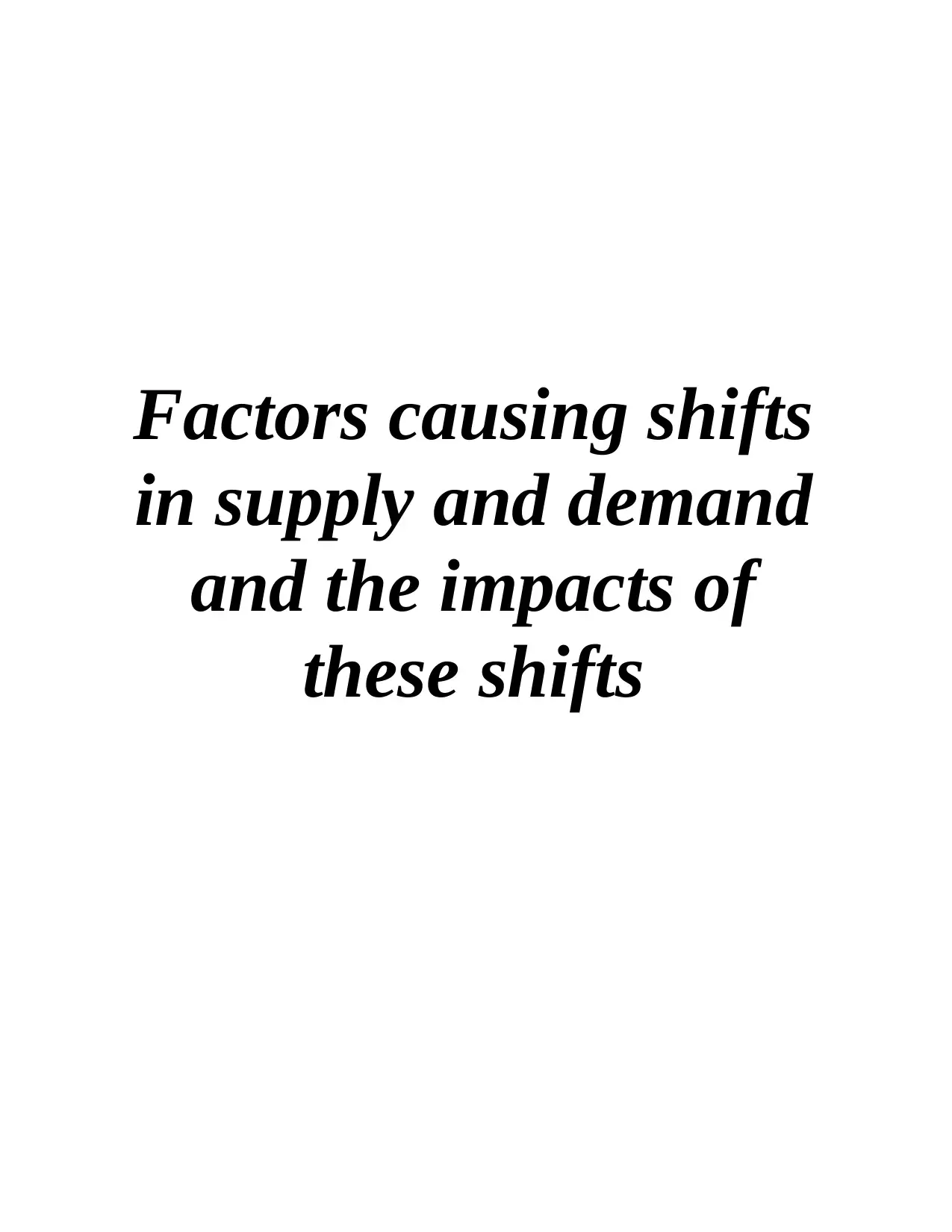
Factors causing shifts
in supply and demand
and the impacts of
these shifts
in supply and demand
and the impacts of
these shifts
Paraphrase This Document
Need a fresh take? Get an instant paraphrase of this document with our AI Paraphraser
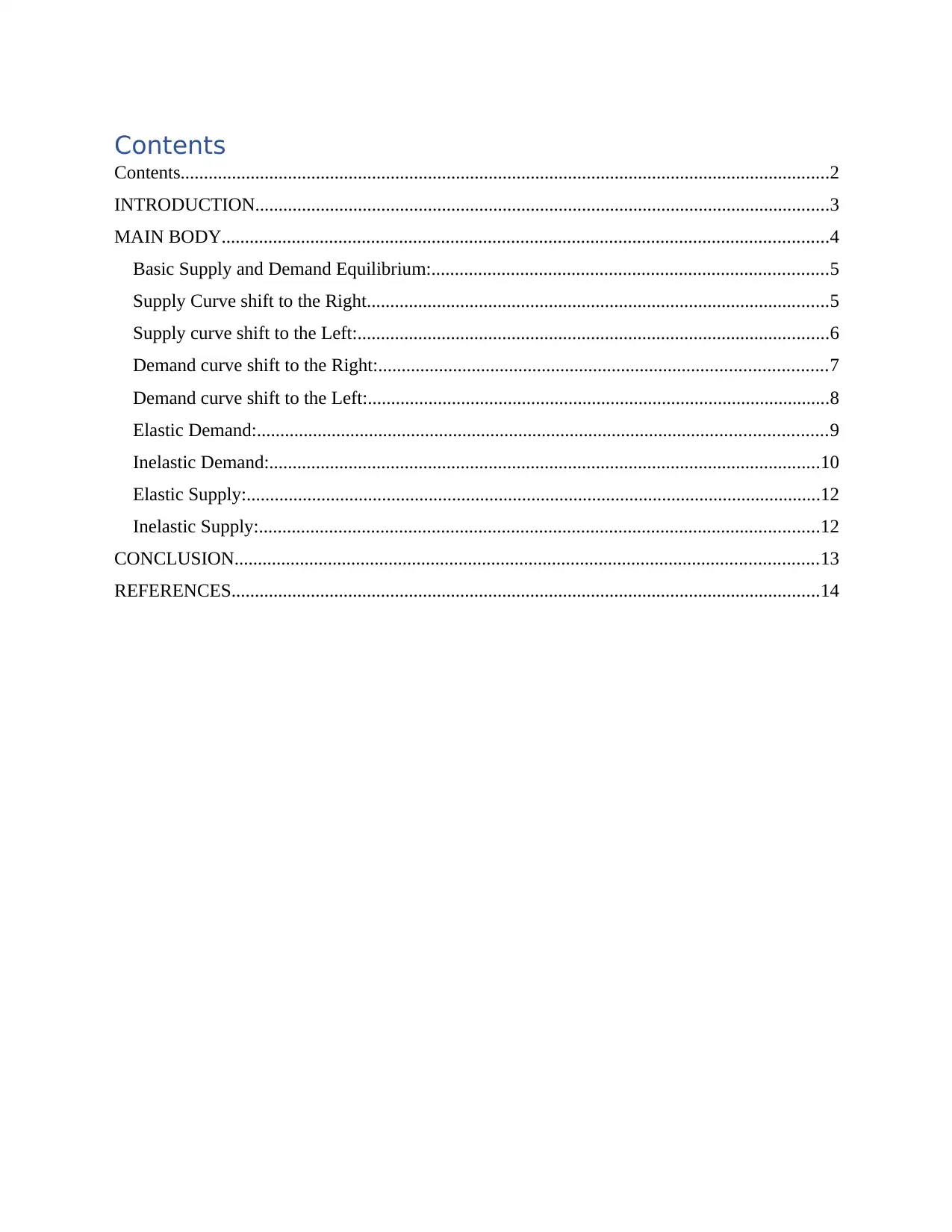
Contents
Contents...........................................................................................................................................2
INTRODUCTION...........................................................................................................................3
MAIN BODY..................................................................................................................................4
Basic Supply and Demand Equilibrium:.....................................................................................5
Supply Curve shift to the Right...................................................................................................5
Supply curve shift to the Left:.....................................................................................................6
Demand curve shift to the Right:................................................................................................7
Demand curve shift to the Left:...................................................................................................8
Elastic Demand:..........................................................................................................................9
Inelastic Demand:......................................................................................................................10
Elastic Supply:...........................................................................................................................12
Inelastic Supply:........................................................................................................................12
CONCLUSION.............................................................................................................................13
REFERENCES..............................................................................................................................14
Contents...........................................................................................................................................2
INTRODUCTION...........................................................................................................................3
MAIN BODY..................................................................................................................................4
Basic Supply and Demand Equilibrium:.....................................................................................5
Supply Curve shift to the Right...................................................................................................5
Supply curve shift to the Left:.....................................................................................................6
Demand curve shift to the Right:................................................................................................7
Demand curve shift to the Left:...................................................................................................8
Elastic Demand:..........................................................................................................................9
Inelastic Demand:......................................................................................................................10
Elastic Supply:...........................................................................................................................12
Inelastic Supply:........................................................................................................................12
CONCLUSION.............................................................................................................................13
REFERENCES..............................................................................................................................14
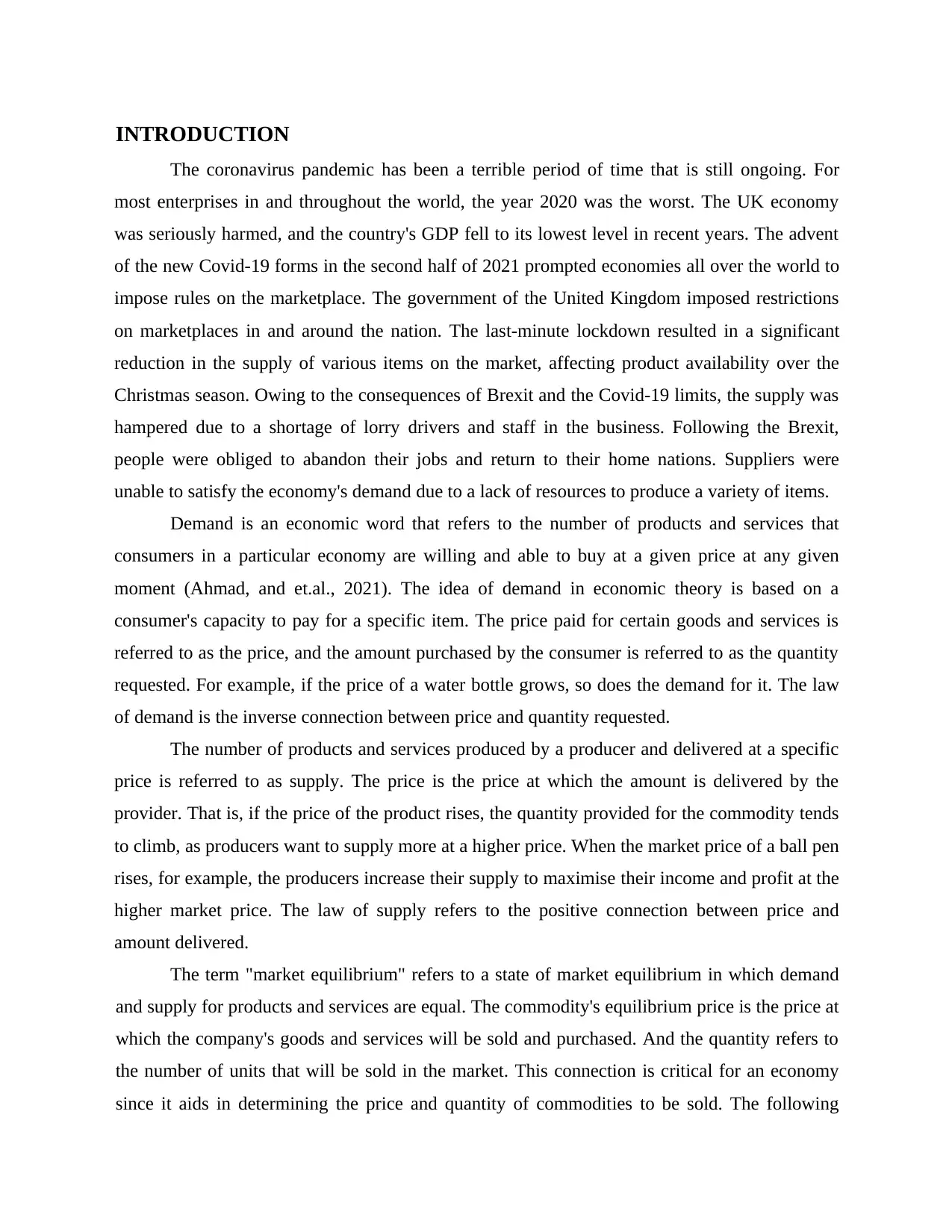
INTRODUCTION
The coronavirus pandemic has been a terrible period of time that is still ongoing. For
most enterprises in and throughout the world, the year 2020 was the worst. The UK economy
was seriously harmed, and the country's GDP fell to its lowest level in recent years. The advent
of the new Covid-19 forms in the second half of 2021 prompted economies all over the world to
impose rules on the marketplace. The government of the United Kingdom imposed restrictions
on marketplaces in and around the nation. The last-minute lockdown resulted in a significant
reduction in the supply of various items on the market, affecting product availability over the
Christmas season. Owing to the consequences of Brexit and the Covid-19 limits, the supply was
hampered due to a shortage of lorry drivers and staff in the business. Following the Brexit,
people were obliged to abandon their jobs and return to their home nations. Suppliers were
unable to satisfy the economy's demand due to a lack of resources to produce a variety of items.
Demand is an economic word that refers to the number of products and services that
consumers in a particular economy are willing and able to buy at a given price at any given
moment (Ahmad, and et.al., 2021). The idea of demand in economic theory is based on a
consumer's capacity to pay for a specific item. The price paid for certain goods and services is
referred to as the price, and the amount purchased by the consumer is referred to as the quantity
requested. For example, if the price of a water bottle grows, so does the demand for it. The law
of demand is the inverse connection between price and quantity requested.
The number of products and services produced by a producer and delivered at a specific
price is referred to as supply. The price is the price at which the amount is delivered by the
provider. That is, if the price of the product rises, the quantity provided for the commodity tends
to climb, as producers want to supply more at a higher price. When the market price of a ball pen
rises, for example, the producers increase their supply to maximise their income and profit at the
higher market price. The law of supply refers to the positive connection between price and
amount delivered.
The term "market equilibrium" refers to a state of market equilibrium in which demand
and supply for products and services are equal. The commodity's equilibrium price is the price at
which the company's goods and services will be sold and purchased. And the quantity refers to
the number of units that will be sold in the market. This connection is critical for an economy
since it aids in determining the price and quantity of commodities to be sold. The following
The coronavirus pandemic has been a terrible period of time that is still ongoing. For
most enterprises in and throughout the world, the year 2020 was the worst. The UK economy
was seriously harmed, and the country's GDP fell to its lowest level in recent years. The advent
of the new Covid-19 forms in the second half of 2021 prompted economies all over the world to
impose rules on the marketplace. The government of the United Kingdom imposed restrictions
on marketplaces in and around the nation. The last-minute lockdown resulted in a significant
reduction in the supply of various items on the market, affecting product availability over the
Christmas season. Owing to the consequences of Brexit and the Covid-19 limits, the supply was
hampered due to a shortage of lorry drivers and staff in the business. Following the Brexit,
people were obliged to abandon their jobs and return to their home nations. Suppliers were
unable to satisfy the economy's demand due to a lack of resources to produce a variety of items.
Demand is an economic word that refers to the number of products and services that
consumers in a particular economy are willing and able to buy at a given price at any given
moment (Ahmad, and et.al., 2021). The idea of demand in economic theory is based on a
consumer's capacity to pay for a specific item. The price paid for certain goods and services is
referred to as the price, and the amount purchased by the consumer is referred to as the quantity
requested. For example, if the price of a water bottle grows, so does the demand for it. The law
of demand is the inverse connection between price and quantity requested.
The number of products and services produced by a producer and delivered at a specific
price is referred to as supply. The price is the price at which the amount is delivered by the
provider. That is, if the price of the product rises, the quantity provided for the commodity tends
to climb, as producers want to supply more at a higher price. When the market price of a ball pen
rises, for example, the producers increase their supply to maximise their income and profit at the
higher market price. The law of supply refers to the positive connection between price and
amount delivered.
The term "market equilibrium" refers to a state of market equilibrium in which demand
and supply for products and services are equal. The commodity's equilibrium price is the price at
which the company's goods and services will be sold and purchased. And the quantity refers to
the number of units that will be sold in the market. This connection is critical for an economy
since it aids in determining the price and quantity of commodities to be sold. The following
⊘ This is a preview!⊘
Do you want full access?
Subscribe today to unlock all pages.

Trusted by 1+ million students worldwide
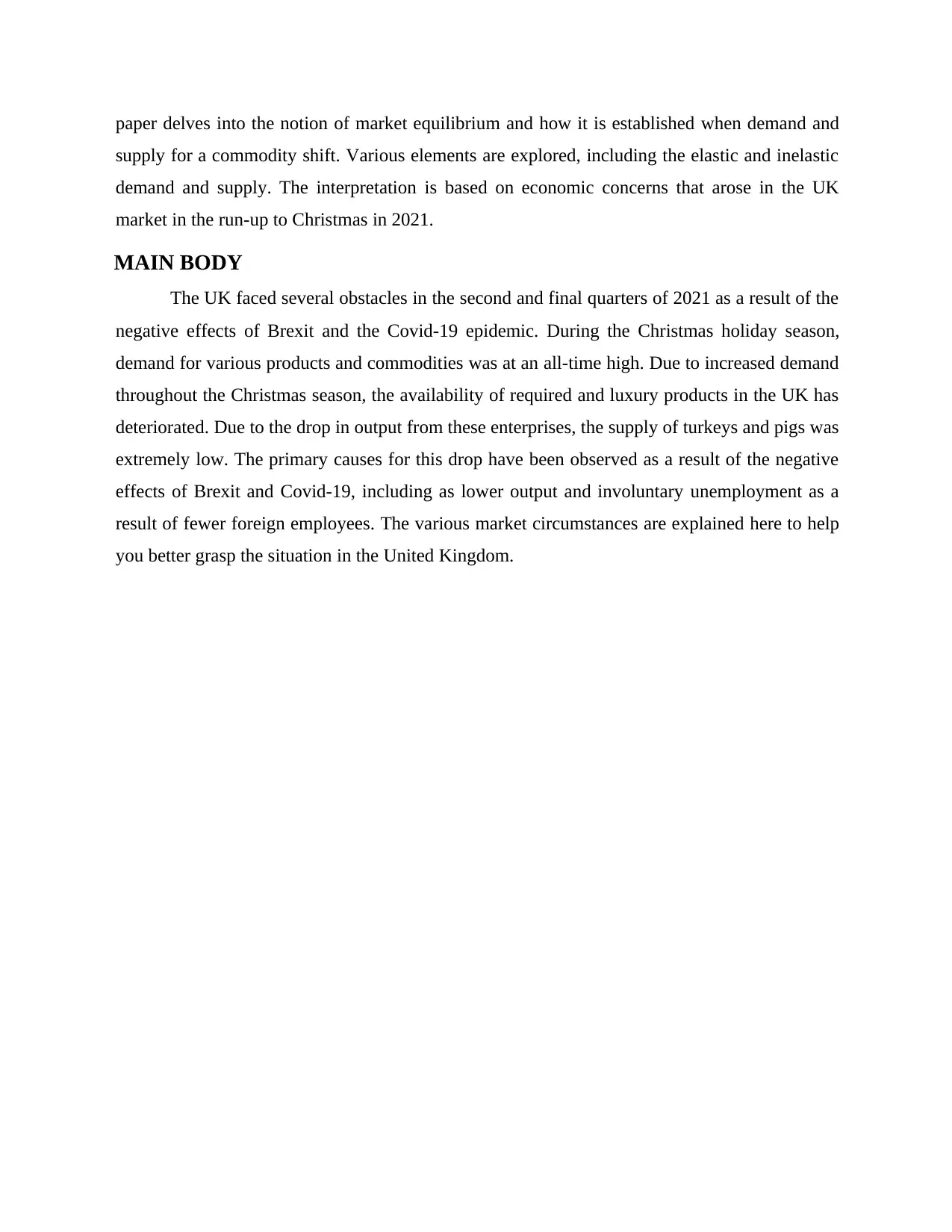
paper delves into the notion of market equilibrium and how it is established when demand and
supply for a commodity shift. Various elements are explored, including the elastic and inelastic
demand and supply. The interpretation is based on economic concerns that arose in the UK
market in the run-up to Christmas in 2021.
MAIN BODY
The UK faced several obstacles in the second and final quarters of 2021 as a result of the
negative effects of Brexit and the Covid-19 epidemic. During the Christmas holiday season,
demand for various products and commodities was at an all-time high. Due to increased demand
throughout the Christmas season, the availability of required and luxury products in the UK has
deteriorated. Due to the drop in output from these enterprises, the supply of turkeys and pigs was
extremely low. The primary causes for this drop have been observed as a result of the negative
effects of Brexit and Covid-19, including as lower output and involuntary unemployment as a
result of fewer foreign employees. The various market circumstances are explained here to help
you better grasp the situation in the United Kingdom.
supply for a commodity shift. Various elements are explored, including the elastic and inelastic
demand and supply. The interpretation is based on economic concerns that arose in the UK
market in the run-up to Christmas in 2021.
MAIN BODY
The UK faced several obstacles in the second and final quarters of 2021 as a result of the
negative effects of Brexit and the Covid-19 epidemic. During the Christmas holiday season,
demand for various products and commodities was at an all-time high. Due to increased demand
throughout the Christmas season, the availability of required and luxury products in the UK has
deteriorated. Due to the drop in output from these enterprises, the supply of turkeys and pigs was
extremely low. The primary causes for this drop have been observed as a result of the negative
effects of Brexit and Covid-19, including as lower output and involuntary unemployment as a
result of fewer foreign employees. The various market circumstances are explained here to help
you better grasp the situation in the United Kingdom.
Paraphrase This Document
Need a fresh take? Get an instant paraphrase of this document with our AI Paraphraser
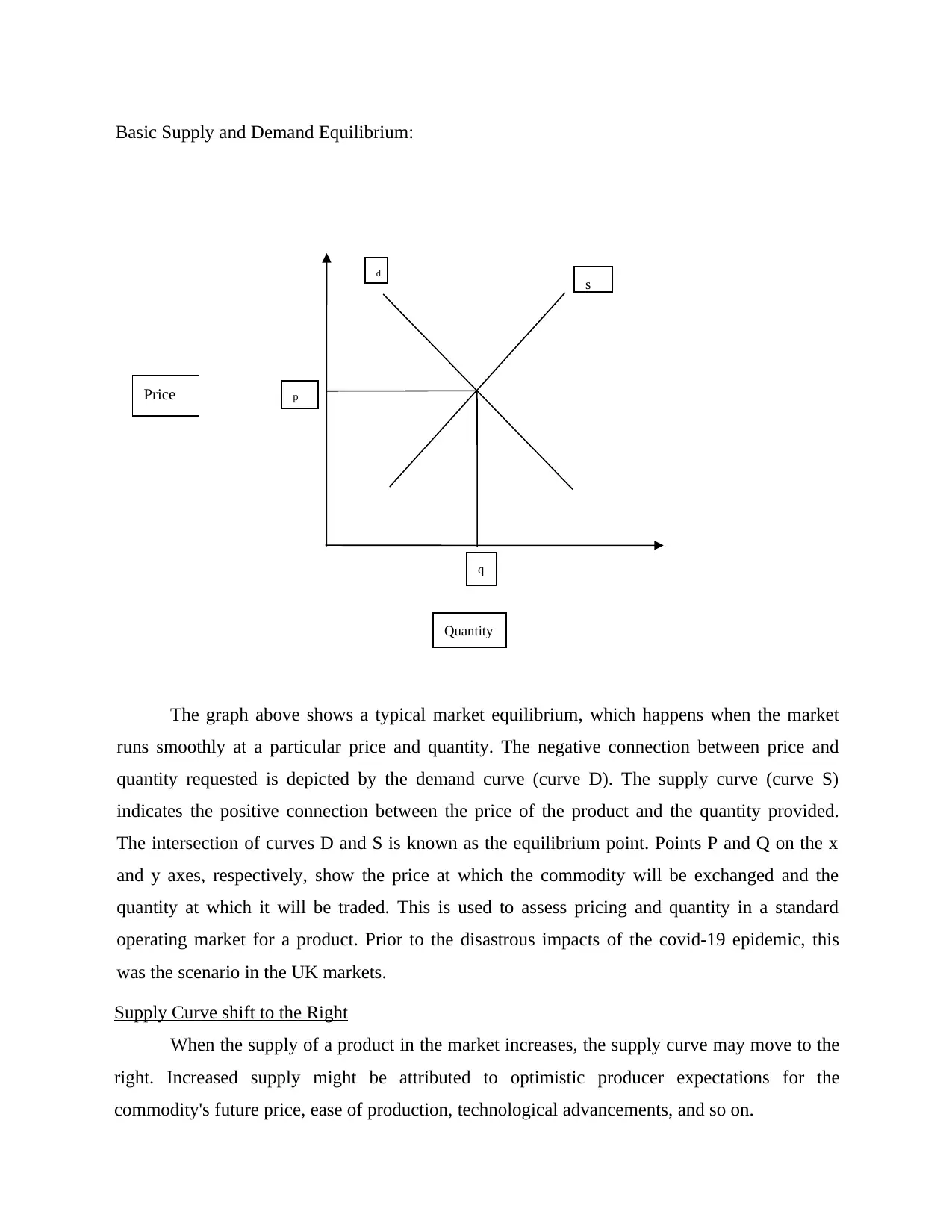
Basic Supply and Demand Equilibrium:
The graph above shows a typical market equilibrium, which happens when the market
runs smoothly at a particular price and quantity. The negative connection between price and
quantity requested is depicted by the demand curve (curve D). The supply curve (curve S)
indicates the positive connection between the price of the product and the quantity provided.
The intersection of curves D and S is known as the equilibrium point. Points P and Q on the x
and y axes, respectively, show the price at which the commodity will be exchanged and the
quantity at which it will be traded. This is used to assess pricing and quantity in a standard
operating market for a product. Prior to the disastrous impacts of the covid-19 epidemic, this
was the scenario in the UK markets.
Supply Curve shift to the Right
When the supply of a product in the market increases, the supply curve may move to the
right. Increased supply might be attributed to optimistic producer expectations for the
commodity's future price, ease of production, technological advancements, and so on.
Price
d
s
p
Quantity
q
The graph above shows a typical market equilibrium, which happens when the market
runs smoothly at a particular price and quantity. The negative connection between price and
quantity requested is depicted by the demand curve (curve D). The supply curve (curve S)
indicates the positive connection between the price of the product and the quantity provided.
The intersection of curves D and S is known as the equilibrium point. Points P and Q on the x
and y axes, respectively, show the price at which the commodity will be exchanged and the
quantity at which it will be traded. This is used to assess pricing and quantity in a standard
operating market for a product. Prior to the disastrous impacts of the covid-19 epidemic, this
was the scenario in the UK markets.
Supply Curve shift to the Right
When the supply of a product in the market increases, the supply curve may move to the
right. Increased supply might be attributed to optimistic producer expectations for the
commodity's future price, ease of production, technological advancements, and so on.
Price
d
s
p
Quantity
q
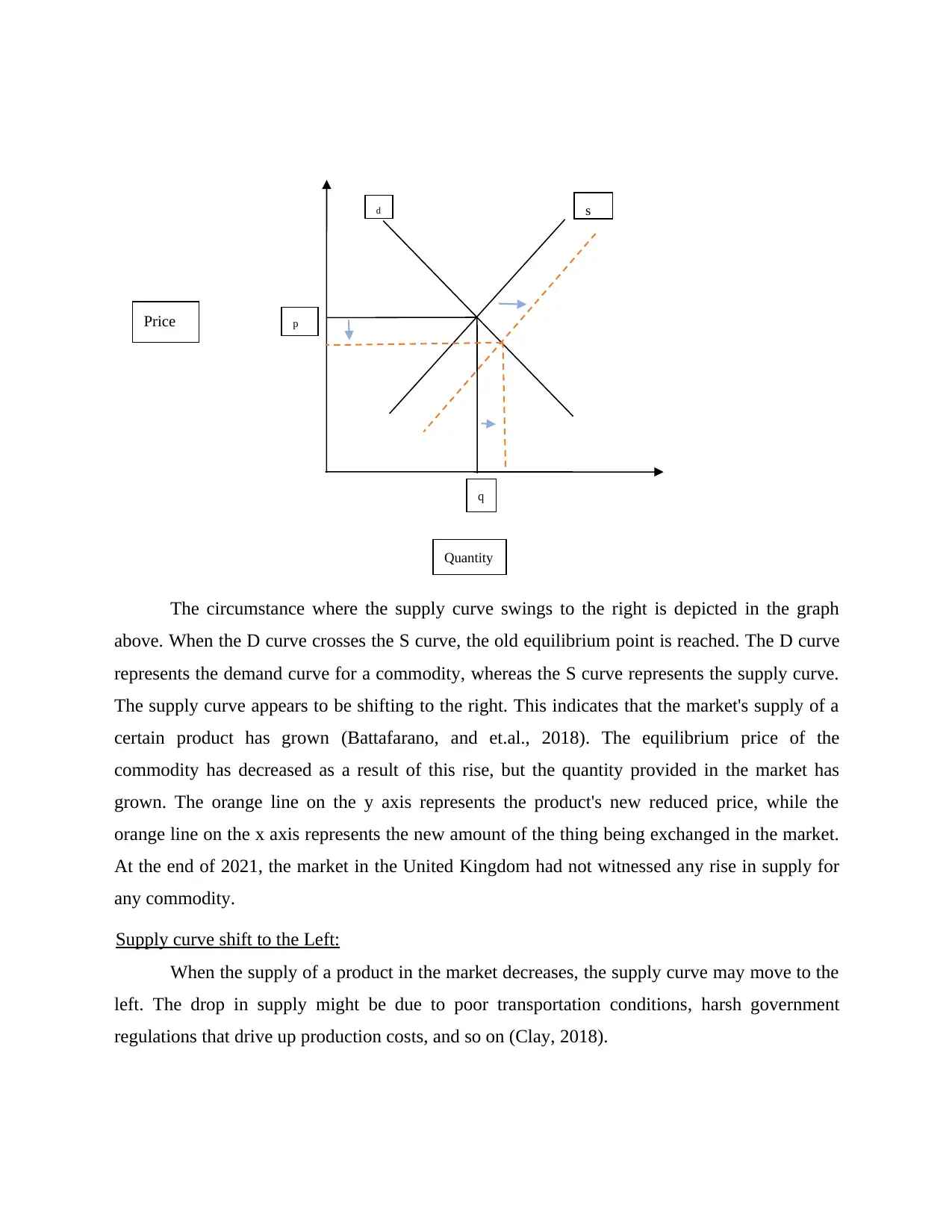
The circumstance where the supply curve swings to the right is depicted in the graph
above. When the D curve crosses the S curve, the old equilibrium point is reached. The D curve
represents the demand curve for a commodity, whereas the S curve represents the supply curve.
The supply curve appears to be shifting to the right. This indicates that the market's supply of a
certain product has grown (Battafarano, and et.al., 2018). The equilibrium price of the
commodity has decreased as a result of this rise, but the quantity provided in the market has
grown. The orange line on the y axis represents the product's new reduced price, while the
orange line on the x axis represents the new amount of the thing being exchanged in the market.
At the end of 2021, the market in the United Kingdom had not witnessed any rise in supply for
any commodity.
Supply curve shift to the Left:
When the supply of a product in the market decreases, the supply curve may move to the
left. The drop in supply might be due to poor transportation conditions, harsh government
regulations that drive up production costs, and so on (Clay, 2018).
Price
d s
p
Quantity
q
above. When the D curve crosses the S curve, the old equilibrium point is reached. The D curve
represents the demand curve for a commodity, whereas the S curve represents the supply curve.
The supply curve appears to be shifting to the right. This indicates that the market's supply of a
certain product has grown (Battafarano, and et.al., 2018). The equilibrium price of the
commodity has decreased as a result of this rise, but the quantity provided in the market has
grown. The orange line on the y axis represents the product's new reduced price, while the
orange line on the x axis represents the new amount of the thing being exchanged in the market.
At the end of 2021, the market in the United Kingdom had not witnessed any rise in supply for
any commodity.
Supply curve shift to the Left:
When the supply of a product in the market decreases, the supply curve may move to the
left. The drop in supply might be due to poor transportation conditions, harsh government
regulations that drive up production costs, and so on (Clay, 2018).
Price
d s
p
Quantity
q
⊘ This is a preview!⊘
Do you want full access?
Subscribe today to unlock all pages.

Trusted by 1+ million students worldwide
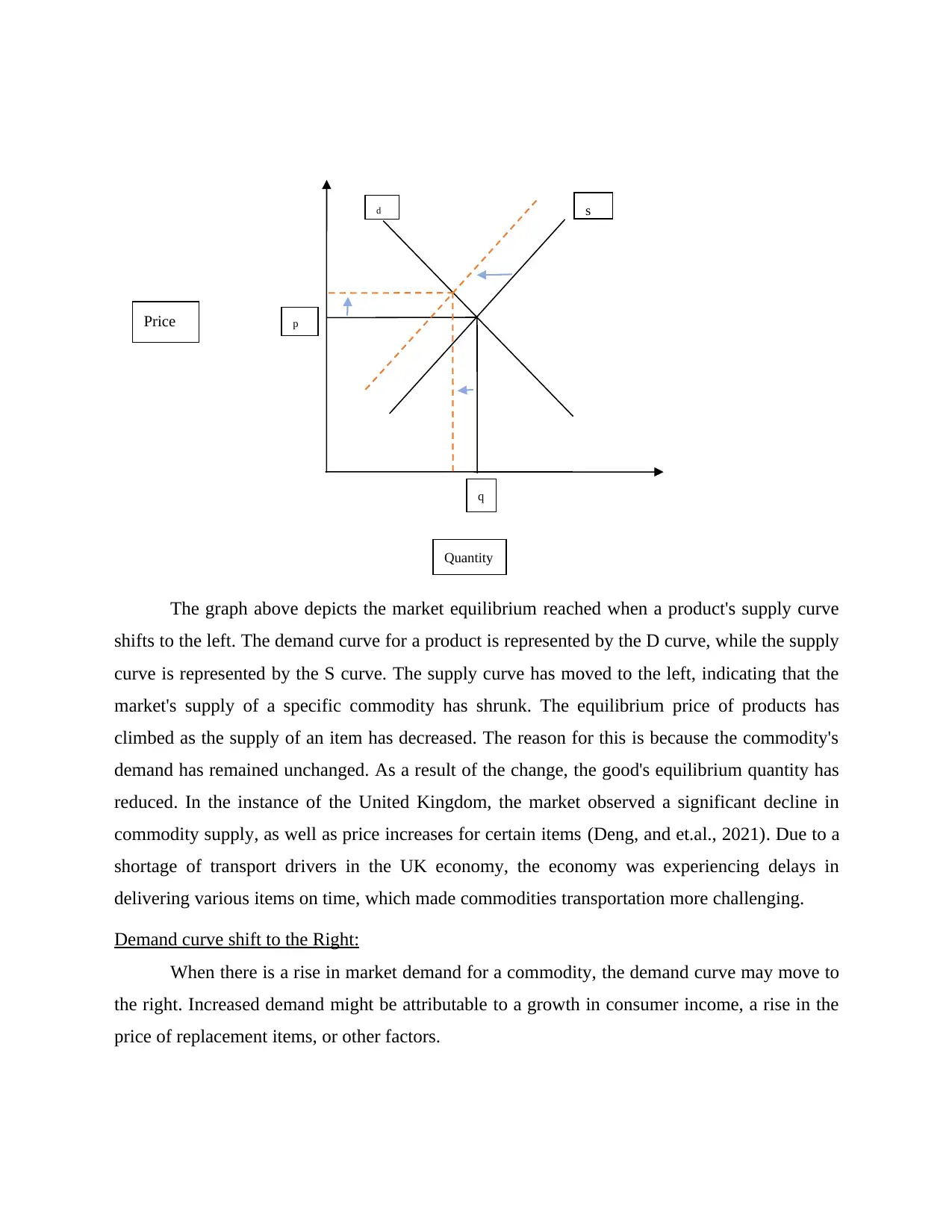
The graph above depicts the market equilibrium reached when a product's supply curve
shifts to the left. The demand curve for a product is represented by the D curve, while the supply
curve is represented by the S curve. The supply curve has moved to the left, indicating that the
market's supply of a specific commodity has shrunk. The equilibrium price of products has
climbed as the supply of an item has decreased. The reason for this is because the commodity's
demand has remained unchanged. As a result of the change, the good's equilibrium quantity has
reduced. In the instance of the United Kingdom, the market observed a significant decline in
commodity supply, as well as price increases for certain items (Deng, and et.al., 2021). Due to a
shortage of transport drivers in the UK economy, the economy was experiencing delays in
delivering various items on time, which made commodities transportation more challenging.
Demand curve shift to the Right:
When there is a rise in market demand for a commodity, the demand curve may move to
the right. Increased demand might be attributable to a growth in consumer income, a rise in the
price of replacement items, or other factors.
Price
d s
p
Quantity
q
shifts to the left. The demand curve for a product is represented by the D curve, while the supply
curve is represented by the S curve. The supply curve has moved to the left, indicating that the
market's supply of a specific commodity has shrunk. The equilibrium price of products has
climbed as the supply of an item has decreased. The reason for this is because the commodity's
demand has remained unchanged. As a result of the change, the good's equilibrium quantity has
reduced. In the instance of the United Kingdom, the market observed a significant decline in
commodity supply, as well as price increases for certain items (Deng, and et.al., 2021). Due to a
shortage of transport drivers in the UK economy, the economy was experiencing delays in
delivering various items on time, which made commodities transportation more challenging.
Demand curve shift to the Right:
When there is a rise in market demand for a commodity, the demand curve may move to
the right. Increased demand might be attributable to a growth in consumer income, a rise in the
price of replacement items, or other factors.
Price
d s
p
Quantity
q
Paraphrase This Document
Need a fresh take? Get an instant paraphrase of this document with our AI Paraphraser
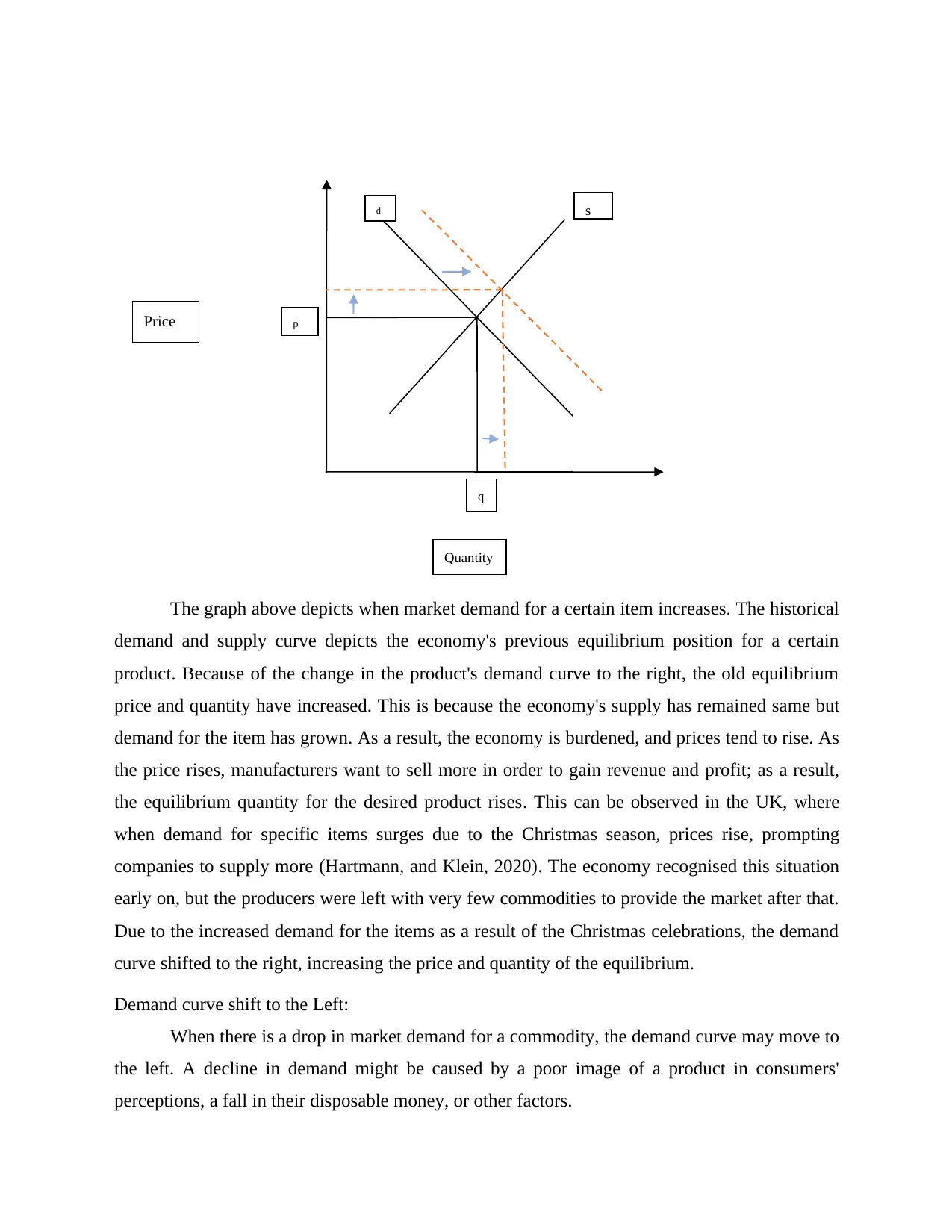
The graph above depicts when market demand for a certain item increases. The historical
demand and supply curve depicts the economy's previous equilibrium position for a certain
product. Because of the change in the product's demand curve to the right, the old equilibrium
price and quantity have increased. This is because the economy's supply has remained same but
demand for the item has grown. As a result, the economy is burdened, and prices tend to rise. As
the price rises, manufacturers want to sell more in order to gain revenue and profit; as a result,
the equilibrium quantity for the desired product rises. This can be observed in the UK, where
when demand for specific items surges due to the Christmas season, prices rise, prompting
companies to supply more (Hartmann, and Klein, 2020). The economy recognised this situation
early on, but the producers were left with very few commodities to provide the market after that.
Due to the increased demand for the items as a result of the Christmas celebrations, the demand
curve shifted to the right, increasing the price and quantity of the equilibrium.
Demand curve shift to the Left:
When there is a drop in market demand for a commodity, the demand curve may move to
the left. A decline in demand might be caused by a poor image of a product in consumers'
perceptions, a fall in their disposable money, or other factors.
Price
d s
p
Quantity
q
demand and supply curve depicts the economy's previous equilibrium position for a certain
product. Because of the change in the product's demand curve to the right, the old equilibrium
price and quantity have increased. This is because the economy's supply has remained same but
demand for the item has grown. As a result, the economy is burdened, and prices tend to rise. As
the price rises, manufacturers want to sell more in order to gain revenue and profit; as a result,
the equilibrium quantity for the desired product rises. This can be observed in the UK, where
when demand for specific items surges due to the Christmas season, prices rise, prompting
companies to supply more (Hartmann, and Klein, 2020). The economy recognised this situation
early on, but the producers were left with very few commodities to provide the market after that.
Due to the increased demand for the items as a result of the Christmas celebrations, the demand
curve shifted to the right, increasing the price and quantity of the equilibrium.
Demand curve shift to the Left:
When there is a drop in market demand for a commodity, the demand curve may move to
the left. A decline in demand might be caused by a poor image of a product in consumers'
perceptions, a fall in their disposable money, or other factors.
Price
d s
p
Quantity
q
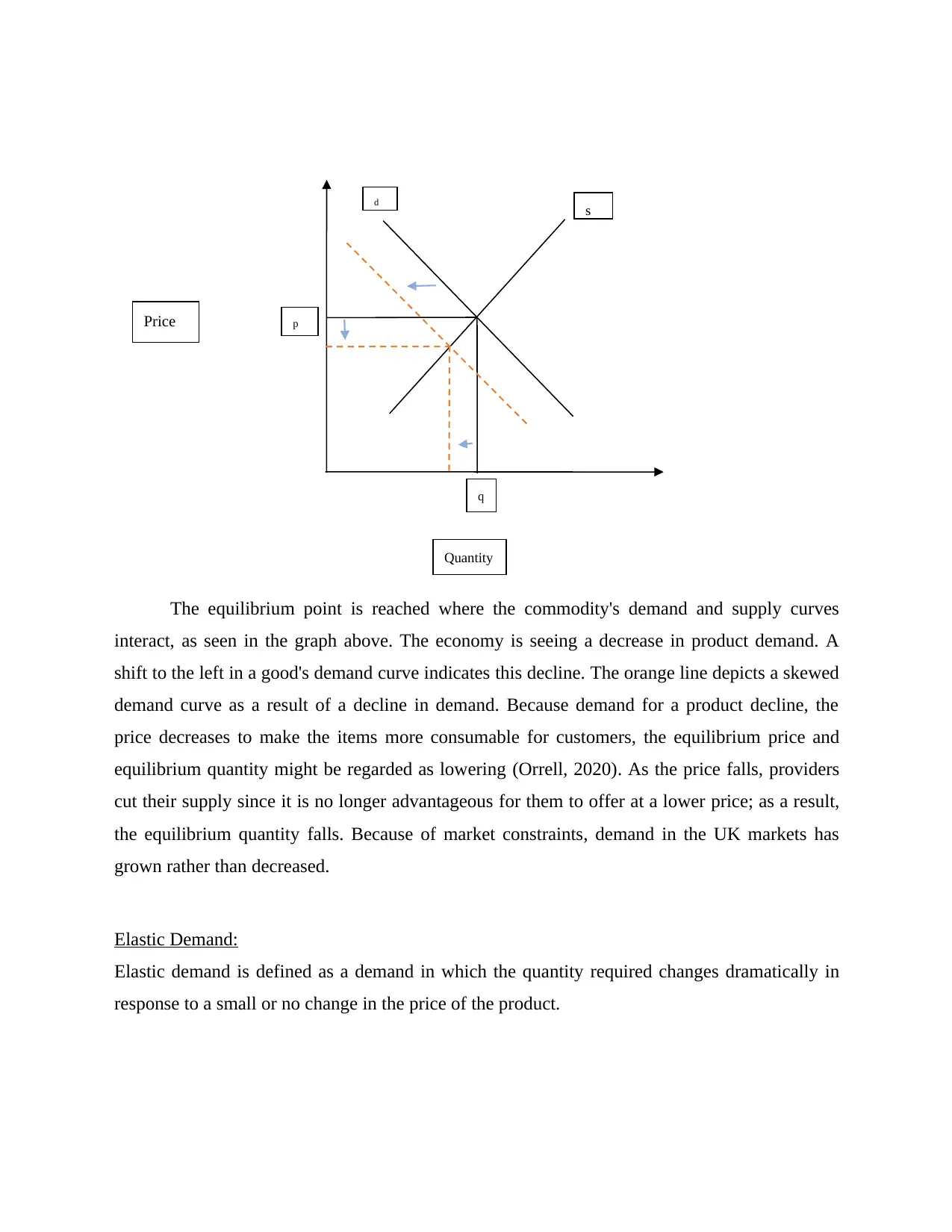
The equilibrium point is reached where the commodity's demand and supply curves
interact, as seen in the graph above. The economy is seeing a decrease in product demand. A
shift to the left in a good's demand curve indicates this decline. The orange line depicts a skewed
demand curve as a result of a decline in demand. Because demand for a product decline, the
price decreases to make the items more consumable for customers, the equilibrium price and
equilibrium quantity might be regarded as lowering (Orrell, 2020). As the price falls, providers
cut their supply since it is no longer advantageous for them to offer at a lower price; as a result,
the equilibrium quantity falls. Because of market constraints, demand in the UK markets has
grown rather than decreased.
Elastic Demand:
Elastic demand is defined as a demand in which the quantity required changes dramatically in
response to a small or no change in the price of the product.
Price
d
s
p
Quantity
q
interact, as seen in the graph above. The economy is seeing a decrease in product demand. A
shift to the left in a good's demand curve indicates this decline. The orange line depicts a skewed
demand curve as a result of a decline in demand. Because demand for a product decline, the
price decreases to make the items more consumable for customers, the equilibrium price and
equilibrium quantity might be regarded as lowering (Orrell, 2020). As the price falls, providers
cut their supply since it is no longer advantageous for them to offer at a lower price; as a result,
the equilibrium quantity falls. Because of market constraints, demand in the UK markets has
grown rather than decreased.
Elastic Demand:
Elastic demand is defined as a demand in which the quantity required changes dramatically in
response to a small or no change in the price of the product.
Price
d
s
p
Quantity
q
⊘ This is a preview!⊘
Do you want full access?
Subscribe today to unlock all pages.

Trusted by 1+ million students worldwide
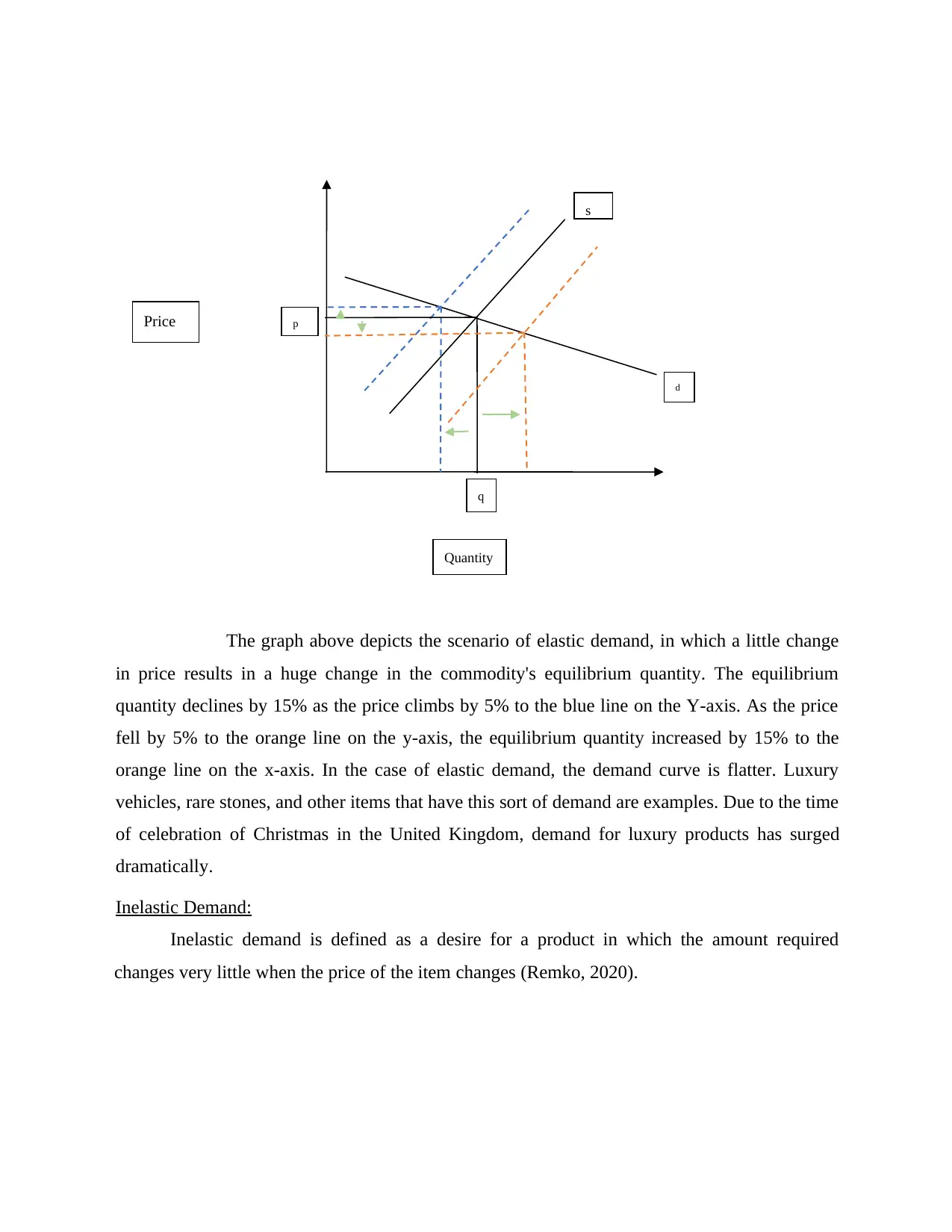
The graph above depicts the scenario of elastic demand, in which a little change
in price results in a huge change in the commodity's equilibrium quantity. The equilibrium
quantity declines by 15% as the price climbs by 5% to the blue line on the Y-axis. As the price
fell by 5% to the orange line on the y-axis, the equilibrium quantity increased by 15% to the
orange line on the x-axis. In the case of elastic demand, the demand curve is flatter. Luxury
vehicles, rare stones, and other items that have this sort of demand are examples. Due to the time
of celebration of Christmas in the United Kingdom, demand for luxury products has surged
dramatically.
Inelastic Demand:
Inelastic demand is defined as a desire for a product in which the amount required
changes very little when the price of the item changes (Remko, 2020).
Price
d
s
p
Quantity
q
in price results in a huge change in the commodity's equilibrium quantity. The equilibrium
quantity declines by 15% as the price climbs by 5% to the blue line on the Y-axis. As the price
fell by 5% to the orange line on the y-axis, the equilibrium quantity increased by 15% to the
orange line on the x-axis. In the case of elastic demand, the demand curve is flatter. Luxury
vehicles, rare stones, and other items that have this sort of demand are examples. Due to the time
of celebration of Christmas in the United Kingdom, demand for luxury products has surged
dramatically.
Inelastic Demand:
Inelastic demand is defined as a desire for a product in which the amount required
changes very little when the price of the item changes (Remko, 2020).
Price
d
s
p
Quantity
q
Paraphrase This Document
Need a fresh take? Get an instant paraphrase of this document with our AI Paraphraser
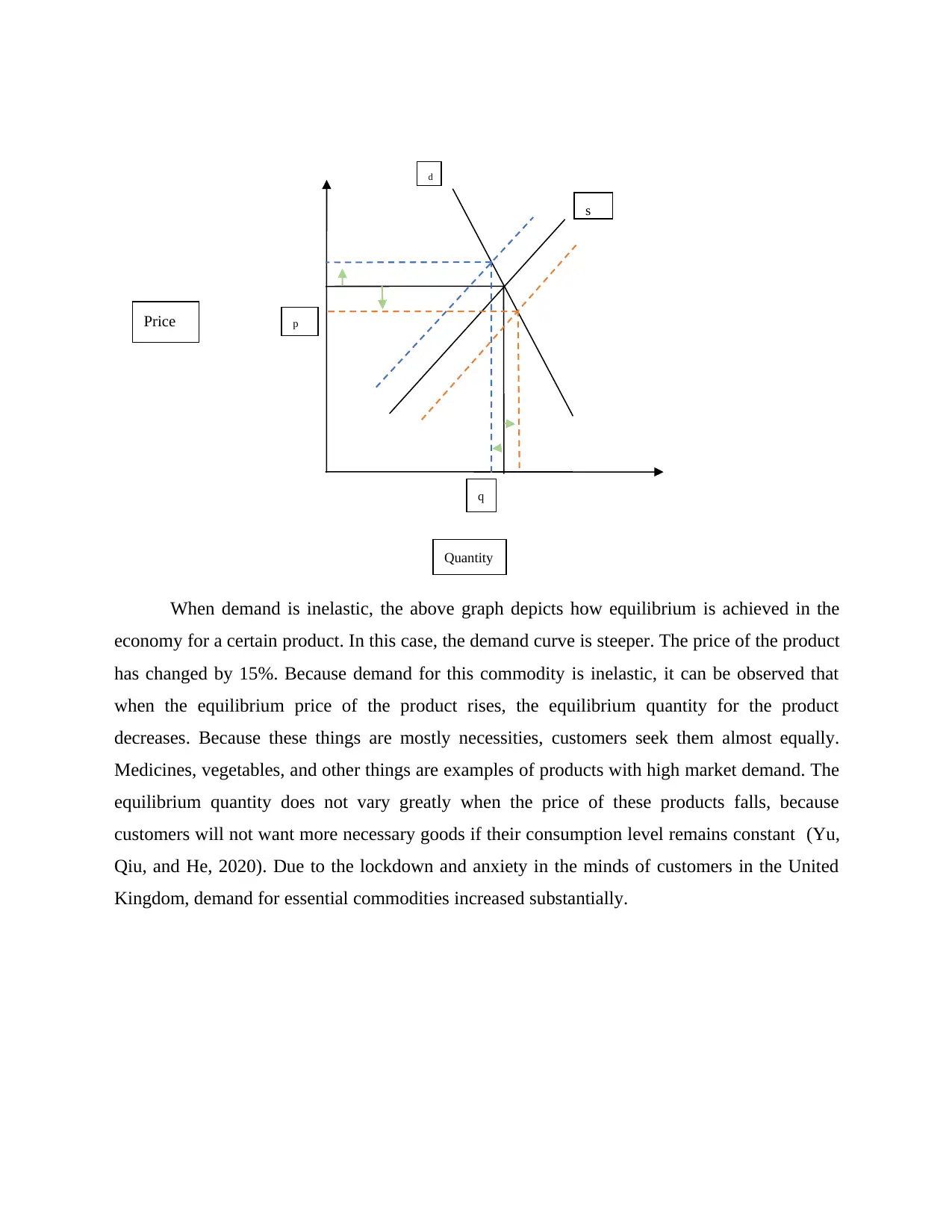
When demand is inelastic, the above graph depicts how equilibrium is achieved in the
economy for a certain product. In this case, the demand curve is steeper. The price of the product
has changed by 15%. Because demand for this commodity is inelastic, it can be observed that
when the equilibrium price of the product rises, the equilibrium quantity for the product
decreases. Because these things are mostly necessities, customers seek them almost equally.
Medicines, vegetables, and other things are examples of products with high market demand. The
equilibrium quantity does not vary greatly when the price of these products falls, because
customers will not want more necessary goods if their consumption level remains constant (Yu,
Qiu, and He, 2020). Due to the lockdown and anxiety in the minds of customers in the United
Kingdom, demand for essential commodities increased substantially.
Price
d
s
p
Quantity
q
economy for a certain product. In this case, the demand curve is steeper. The price of the product
has changed by 15%. Because demand for this commodity is inelastic, it can be observed that
when the equilibrium price of the product rises, the equilibrium quantity for the product
decreases. Because these things are mostly necessities, customers seek them almost equally.
Medicines, vegetables, and other things are examples of products with high market demand. The
equilibrium quantity does not vary greatly when the price of these products falls, because
customers will not want more necessary goods if their consumption level remains constant (Yu,
Qiu, and He, 2020). Due to the lockdown and anxiety in the minds of customers in the United
Kingdom, demand for essential commodities increased substantially.
Price
d
s
p
Quantity
q
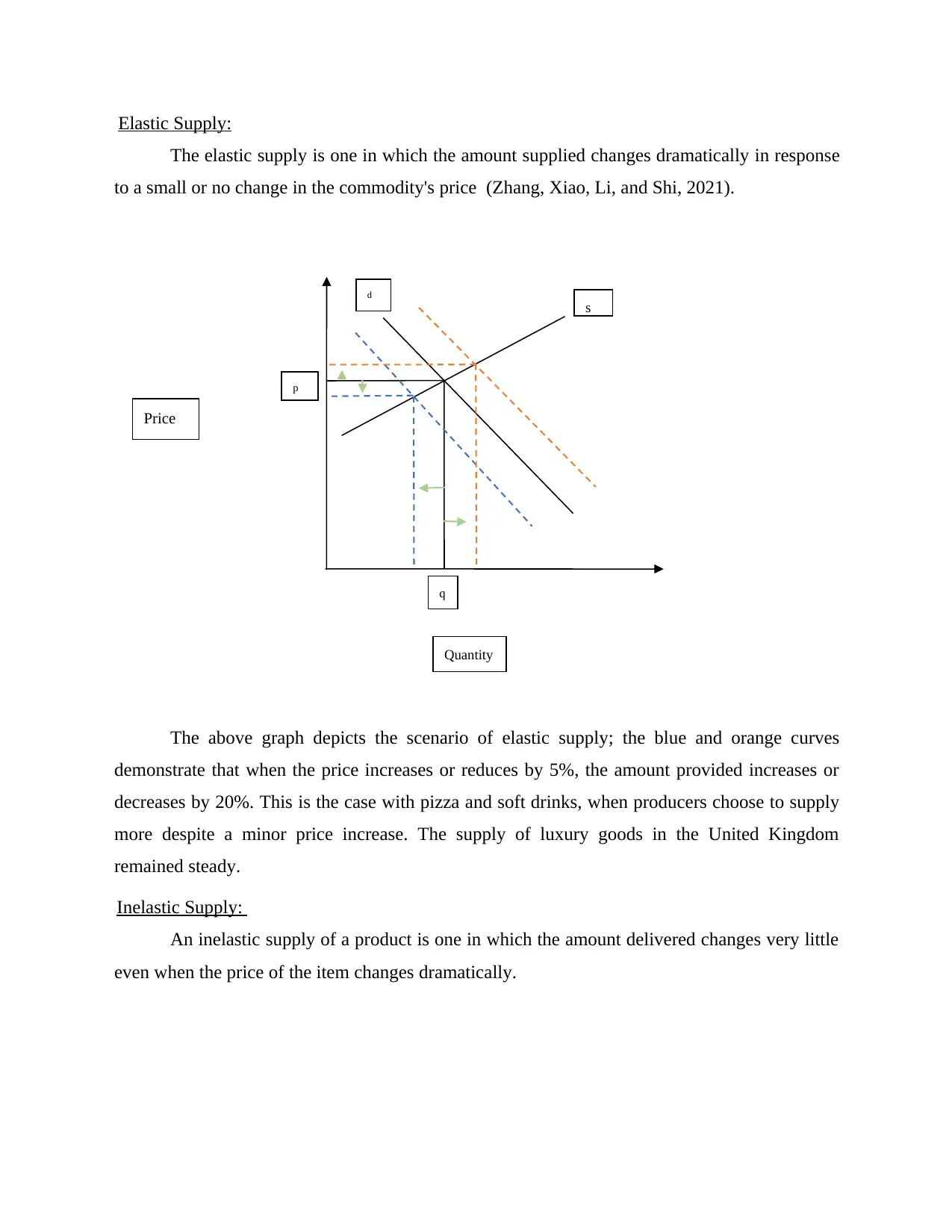
Elastic Supply:
The elastic supply is one in which the amount supplied changes dramatically in response
to a small or no change in the commodity's price (Zhang, Xiao, Li, and Shi, 2021).
The above graph depicts the scenario of elastic supply; the blue and orange curves
demonstrate that when the price increases or reduces by 5%, the amount provided increases or
decreases by 20%. This is the case with pizza and soft drinks, when producers choose to supply
more despite a minor price increase. The supply of luxury goods in the United Kingdom
remained steady.
Inelastic Supply:
An inelastic supply of a product is one in which the amount delivered changes very little
even when the price of the item changes dramatically.
Price
d
s
p
Quantity
q
The elastic supply is one in which the amount supplied changes dramatically in response
to a small or no change in the commodity's price (Zhang, Xiao, Li, and Shi, 2021).
The above graph depicts the scenario of elastic supply; the blue and orange curves
demonstrate that when the price increases or reduces by 5%, the amount provided increases or
decreases by 20%. This is the case with pizza and soft drinks, when producers choose to supply
more despite a minor price increase. The supply of luxury goods in the United Kingdom
remained steady.
Inelastic Supply:
An inelastic supply of a product is one in which the amount delivered changes very little
even when the price of the item changes dramatically.
Price
d
s
p
Quantity
q
⊘ This is a preview!⊘
Do you want full access?
Subscribe today to unlock all pages.

Trusted by 1+ million students worldwide
1 out of 14
Related Documents
Your All-in-One AI-Powered Toolkit for Academic Success.
+13062052269
info@desklib.com
Available 24*7 on WhatsApp / Email
![[object Object]](/_next/static/media/star-bottom.7253800d.svg)
Unlock your academic potential
Copyright © 2020–2025 A2Z Services. All Rights Reserved. Developed and managed by ZUCOL.





